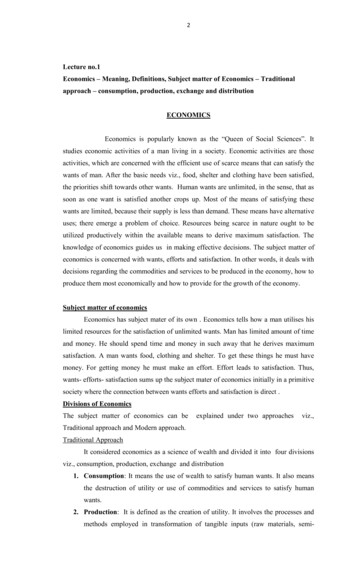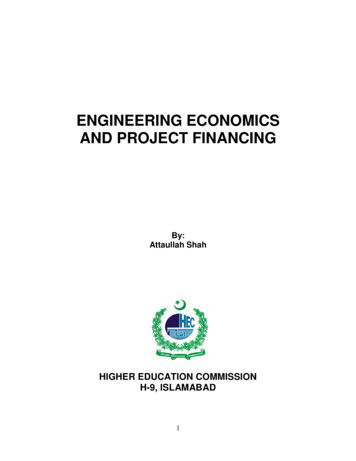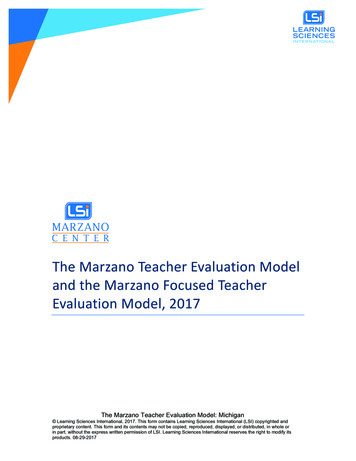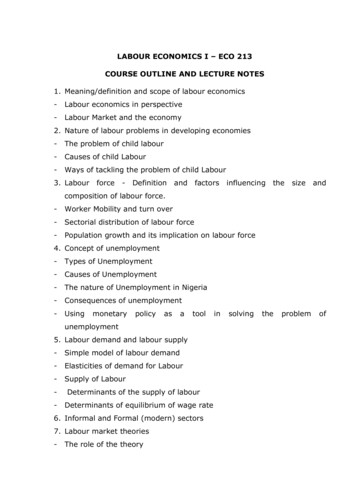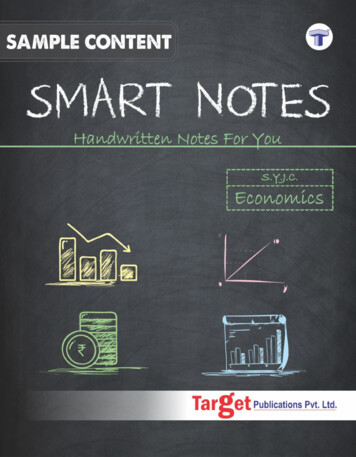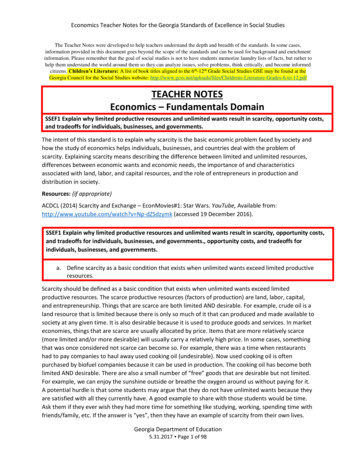
Transcription
Economics Teacher Notes for the Georgia Standards of Excellence in Social StudiesThe Teacher Notes were developed to help teachers understand the depth and breadth of the standards. In some cases,information provided in this document goes beyond the scope of the standards and can be used for background and enrichmentinformation. Please remember that the goal of social studies is not to have students memorize laundry lists of facts, but rather tohelp them understand the world around them so they can analyze issues, solve problems, think critically, and become informedcitizens. Children’s Literature: A list of book titles aligned to the 6th-12th Grade Social Studies GSE may be found at theGeorgia Council for the Social Studies website: ture-Grades-6-to-12.pdfTEACHER NOTESEconomics – Fundamentals DomainSSEF1 Explain why limited productive resources and unlimited wants result in scarcity, opportunity costs,and tradeoffs for individuals, businesses, and governments.The intent of this standard is to explain why scarcity is the basic economic problem faced by society andhow the study of economics helps individuals, businesses, and countries deal with the problem ofscarcity. Explaining scarcity means describing the difference between limited and unlimited resources,differences between economic wants and economic needs, the importance of and characteristicsassociated with land, labor, and capital resources, and the role of entrepreneurs in production anddistribution in society.Resources: (if appropriate)ACDCL (2014) Scarcity and Exchange – EconMovies#1: Star Wars. YouTube, Available from:http://www.youtube.com/watch?v Np-dZSdzymk (accessed 19 December 2016).SSEF1 Explain why limited productive resources and unlimited wants result in scarcity, opportunity costs,and tradeoffs for individuals, businesses, and governments., opportunity costs, and tradeoffs forindividuals, businesses, and governments.a. Define scarcity as a basic condition that exists when unlimited wants exceed limited productiveresources.Scarcity should be defined as a basic condition that exists when unlimited wants exceed limitedproductive resources. The scarce productive resources (factors of production) are land, labor, capital,and entrepreneurship. Things that are scarce are both limited AND desirable. For example, crude oil is aland resource that is limited because there is only so much of it that can produced and made available tosociety at any given time. It is also desirable because it is used to produce goods and services. In marketeconomies, things that are scarce are usually allocated by price. Items that are more relatively scarce(more limited and/or more desirable) will usually carry a relatively high price. In some cases, somethingthat was once considered not scarce can become so. For example, there was a time when restaurantshad to pay companies to haul away used cooking oil (undesirable). Now used cooking oil is oftenpurchased by biofuel companies because it can be used in production. The cooking oil has become bothlimited AND desirable. There are also a small number of “free” goods that are desirable but not limited.For example, we can enjoy the sunshine outside or breathe the oxygen around us without paying for it.A potential hurdle is that some students may argue that they do not have unlimited wants because theyare satisfied with all they currently have. A good example to share with those students would be time.Ask them if they ever wish they had more time for something like studying, working, spending time withfriends/family, etc. If the answer is “yes”, then they have an example of scarcity from their own lives.Georgia Department of Education5.31.2017 Page 1 of 98
Economics Teacher Notes for the Georgia Standards of Excellence in Social StudiesAnother hurdle for students is recognizing the difference between scarcity and a shortage. Scarcityalways exists while a shortage is temporary. Shortages occur when a resource, good, or service becomesunavailable for a period of time do to circumstances affecting the market. For instance, if a gasolinepipeline is damaged and has to be shut down for repair, geographic areas that get fuel from thatpipeline may find their gas stations temporarily out of fuel. Gasoline is always scarce (limited anddesirable). However, in this example, the market for gasoline is experiencing a temporary shortage untilthe pipeline is repaired.Visual 1: Is it scarce? ChartExampleIs it limited?Is it desirable?Is it scarce?Time YES YES YESWater YES YES YESGarbage YES NO NOAir We Breathe NO YES NOResources:“Economics Basics: What is Economics? Investopedia.” Investopedia. 2014. Accessed December 19,2016. conomics1.asp.SSEF1 Explain why limited productive resources and unlimited wants result in scarcity, opportunity costs,and tradeoffs for individuals, businesses, and governments., opportunity costs, and tradeoffs forindividuals, businesses, and governments.b. Define and give examples of productive resources (i.e. factors of production): natural resources (i.e.land), human resources (i.e. labor and human capital), physical capital and entrepreneurship.Productive resources, also known as factors of production, are scarce items used in the production ofgoods and services in an economy. Natural resources, also known as land resources, are the gifts ofnature we use to produce goods and services. For example, a tree is a natural resource used in theproduction of goods like lumber or paper. Human resources are the people involved in the productionof goods and services. People offer their time to production as well as their physical abilities, knowledge,and skills. The abilities each person brings to the production process is known as their human capital.Producers of goods and services need physical capital too. Physical capital refers to tools, machines, andstructures used over and over again in the production of goods and services. While natural, human, andcapital resources are essential to production, we rely on the fourth productive resource,entrepreneurship, to bring the resources together in innovative ways to produce a product. In thesatirical cartoon below published in 1914 by Puck, examples of each productive resource can be found.(However, we could certainly argue about how productive each of them are in the drawing.) Naturalresources include the chickens, the cow, and the pig. Human resources include the pig masseuse, thecow manicurist, the fashionable gleaners, the sower, the butler, and the chicken nurse. Capitalresources include the mower, the scarecrow, the studio stable, and the pig massage table.Entrepreneurship is embodied in the gentleman farmer himself although his motivation seems to becrop art rather than profit.Georgia Department of Education5.31.2017 Page 2 of 98
Economics Teacher Notes for the Georgia Standards of Excellence in Social StudiesCitation: Mayer, H. (1914) "The gentleman farmer" / Hy Mayer ; by Hy Mayer. New York: Published byPuck Publishing Corporation, 295-309 Lafayette Street, June 6. [Image] Retrieved from the Library ofCongress, https://www.loc.gov/item/2011649792.Annotated Resources that relate specifically to the element"Factors of Production - The Economic Lowdown Podcast ." Federal Reserve Bank of St. Louis. N.p., n.d.Web. 14 Jan. 2017. own-podcast-series .SSEF1 Explain why limited productive resources and unlimited wants result in scarcity, opportunity costs,and tradeoffs for individuals, businesses, and governments., opportunity costs, and tradeoffs forindividuals, businesses, and governments.c. Explain the motivations that influence entrepreneurs to take risks (e.g., profit, job creation,innovation, and improving society).Becoming an entrepreneur usually involves taking risks such as using one’s own financial resources tomake a prototype of a product or buy the capital resources required to start the business. Someentrepreneurs may have to quit jobs from which they receive a relatively secure, predictable income inorder to have enough time to invest in their new enterprise. In most cases, entrepreneurs begin newbusinesses because they believe the potential rewards of success outweigh the potential costsassociated with the risks. The motivations of entrepreneurs include profit, job creation, innovation, andimproving society. Traditionally, the field of economics sees the profit motive as the primary driver ofGeorgia Department of Education5.31.2017 Page 3 of 98
Economics Teacher Notes for the Georgia Standards of Excellence in Social Studiesentrepreneurship. Those who start private firms believe they can operate the business in a way that therevenues (price times the quantity of goods/services sold) they receive will be greater than the costs(costs of production plus the income they gave up to start the business). In very basic terms, profit isequal to a firm’s revenue minus its costs. Entrepreneurs may also be motivated by the opportunity tocreate a successful business that can provide jobs for people in the industry. According to a 2015 reportby the Kauffman Foundation, new businesses accounted for ALL net new job creation and 20 percent ofgross job creation. Innovation is another key motivation. Many successful entrepreneurs work asemployee experts in their industry before venturing out on their own. During their time as employees,they often see ways companies could improve efficiency or production. They may apply their expertiseto new products during their non-working hours. At some point, the desire to put their ideas to the testmay become greater than their need for the security of a regular salary. Finally, some entrepreneursstart for-profit companies or non-profit organizations because they believe their product or service willimprove society. For example, there are microfinance companies linking individual lenders to individualborrowers. This service provides financial resources to people who would be unlikely to qualify fortraditional bank loans and a return to lenders who would like to see their money help grow thebusinesses of others.Annotated Resources that relate specifically to the elementEntrepreneur Video Series (2015, October 13). Retrieved February 24, 2017, r-VideoJackson, J. W. (2015, September 1). TheImportance of Young Firms for Economic Growth. Retrieved February 24, 2017, ng-firms-for-economic-growthWilliams, P., Kizer, S., Mares, L., & Barnes, E. (2015, September 01). Entrepreneurs – Dallas Fed.Retrieved February 24, 2017, from .(Open the Entrepreneurs PDF from this link) Federal Reserve Bank of Dallas. (n.d.). Retrieved April29, 2017, from SSEF1 Explain why limited productive resources and unlimited wants result in scarcity, opportunity costs,and tradeoffs for individuals, businesses, and governments., opportunity costs, and tradeoffs forindividuals, businesses, and governments.d. Define opportunity cost as the next best alternative given up when individuals, businesses, andgovernments confront scarcity by making choices.The study of economics is all about the choices made by individuals, businesses, and governments. Froman economist’s view, all choices involve both benefits and cost. The value of one’s next best alternativegiven up when a choice is made is called opportunity cost. Consider the following political cartoon. Inthe cartoon, Cuba faces a choice between accepting the terms of the Platt Amendment, which wouldseriously limit its sovereignty, but guarantee Cuban sugar exporters access to the U.S. market. Cubacould also pressure the United States to honor the Teller Amendment guaranteeing Cubanindependence without limits to its sovereignty and face high import tariffs on Cuban sugar entering theUnited States. Cuba choose to incorporate the Platt Amendment terms into its constitution. Cuba gainedthe economic benefits associated with it sugar trade with the United States, but the opportunity costGeorgia Department of Education5.31.2017 Page 4 of 98
Economics Teacher Notes for the Georgia Standards of Excellence in Social Studieswas loss of the right to enter into international treaties with other foreign powers and loss of control ofparts of its territory.Annotated Resources that relate specifically to the elementThe United States, Cuba, and the Platt Amendment, 1901. (n.d.). Retrieved February 24, 2017, /plattGeorgia Department of Education5.31.2017 Page 5 of 98
Economics Teacher Notes for the Georgia Standards of Excellence in Social StudiesKeppler, U. J. (1902) Cuba's choice / Keppler. N.Y.: J. Ottmann Lith. Co., Puck Bldg., September 3. [Image]Retrieved from the Library of Congress, https://www.loc.gov/item/2010652150/.Wolla, S. (2013, January 1). Choices Are Everywhere: Why Can't We Just Have It All? (Page OneEconomics Classroom Edition). Retrieved February 24, 2017, why-cant-we-just-have-it-allSSEF2 Give examples of how rational decision making entails comparing the marginal benefits and themarginal costs of an action.The intent of this standard is to explain and give examples of rational decision making. The study ofeconomics traditionally assumes that individuals, businesses, and governments behave rationally whenfaced with choices. A rational decision is based on comparing the marginal benefits and the marginalcosts of a choice or action. Marginal in economics means incremental or small changes. The rationaldecision is the one in which the marginal benefit of the cost is greater than or equal to the marginal costof the choice.Resources: (if appropriate)AP Microeconomics - Marginal Analysis. (n.d.). Retrieved February 24, 2017, marginal-analysisClifford, J. (2014, January 16). Retrieved February 24, 2017, fromhttps://www.youtube.com/watch?v 0BAMv6lV2t4SSEF2 Give examples of how rational decision making entails comparing the marginal benefits and themarginal costs of an action.a. Define marginal cost and marginal benefit.Marginal is defined in economics as small or incremental change. Marginal benefit refers to theadditional positive value one receives from undertaking one more unit of an action. For example, themarginal benefit of running one more mile after running the previous two miles could be the additionalcalories burned. Marginal cost refers to the additional amount of effort, expense, or time one incursfrom undertaking one more unit of an action. For example, the marginal cost of running one more mileafter running the previous two miles could be ten minutes of time one could have devoted to anotherpursuit such as studying for an exam.Annotated Resources that relate specifically to the elementMarginal Analysis. (n.d.). Retrieved April 29, 2017, from a Department of Education5.31.2017 Page 6 of 98
Economics Teacher Notes for the Georgia Standards of Excellence in Social StudiesSSEF2 Give examples of how rational decision making entails comparing the marginal benefits and themarginal costs of an action.b. Explain that rational decisions occur when the marginal benefits of an action equal or exceed themarginal costs.Rational actors in the economy will only select a choice if the marginal benefits of it are equal to orgreater than the marginal costs of the action. In microeconomics, one benefit a firm receives fromselling a product is the revenue (price times the quantity). One cost associated with producing a productis the cost of the human resources required to make the product. A rational firm wants to know howmany workers it should hire to maximize its profit. Profit is revenue minus costs. An economist wouldtell the firm to hire the number of workers at which the marginal revenue generated by the humanresource is equal to the marginal cost of hiring the human resource. Consider an example in which thewage for each worker you hire is 10.00 an hour and the price of your product is 2.50. In the tablebelow, the marginal revenue (benefit) of each additional worker is equal to the marginal cost of eachadditional worker when the firm hires worker #3. A rational firm would not hire the 4th worker becausethe marginal cost of that worker is greater than the marginal benefit.Number ofWorkersTotal UnitsProducedMarginalNumber ofUnitsProducedPrice ofEach UnitProducedTotalRevenue forthe UnitsProducedMarginalRevenue forGeneratedby EachAdditionalWorkerMarginalCost ofHiring EachAdditionalWorker00 2.500166 2.50 15.00 15.00 10.002115 2.50 27.50 12.50 10.003*154 2.50 37.50 10.00* 10.00*4183 2.50 45.00 7.50 10.005202 2.50 50.00 5.00 10.006211 2.50 52.50 2.50 10.00Annotated Resources that relate specifically to the elementGreeves, M. (n.d.). Marginal Analysis. Retrieved February 24, 2017, eorgia Department of Education5.31.2017 Page 7 of 98
Economics Teacher Notes for the Georgia Standards of Excellence in Social StudiesSSEF2 Give examples of how rational decision making entails comparing the marginal benefits and themarginal costs of an action.c. Explain that people, businesses, and governments respond to positive and negative incentives inpredictable ways.In the study of economics, an incentive motivates individuals, businesses, and/or governments toundertake an action or avoid an action. Incentives are positive when these actors in the economychoose an option associated with a perceived benefit or gain. Incentives are negative, sometimes calleddisincentives, when actors in the economy avoid a particular option because they associate it with a costthat is too high. Traditionally, the field of economist believes individuals, businesses, and governmentswill respond predictably to positive and negative incentives. The chart below gives examples of bothpositive and negative incentives for individuals, businesses, and governments as well as the predictedresponse of the economic actor.Georgia Department of Education5.31.2017 Page 8 of 98
Economics Teacher Notes for the Georgia Standards of Excellence in Social StudiesEconomic ActorIncentiveIs it positiveornegative?Predicted ResponseIndividualsAn income tax credit forpurchasing a home. (A taxcredit is money you receivefrom the government forundertaking an action thegovernment views asdesirable.)PositiveTax paying members ofsociety are more likely tobuy a home than theywould be without the taxcreditIndividualsIndividuals caught breakingtraffic laws face fines or otherpenalties.NegativeDrivers are less likely tobreak traffic laws if theyface out of pocket costs forbreaking the laws.BusinessesA subsidy given to firms thatdevelop new products whichimprove public health orsafety. (A subsidy is amonetary transfer from agovernment to a business forundertaking a particulardesirable action.)PositiveBusinesses will be morelikely to invest in thecapital goods and researchfor product or service if thegovernment providesmoney to help offset thecosts of the investment.BusinessesA tax on the output of a goodor service. Sometimesimposed by a governmentwhen the production of agood or service is deemedharmful to society or theenvironment.NegativeBusinesses faced with a taxon the good or service theyproduce may decreaseproduction of the productdue to the higher cost, thusreducing harm to society.GovernmentsLow interest loans foreconomic development frominternational organizationslike the World Bank.PositiveWhen governments havelow cost credit available forpoverty alleviationprojects, they are morelikely to undertake thoseinitiatives.GovernmentsRules tied funds from theFederal government to thestate government fortransportation.NegativeState governments wereonce compelled to lowerthe speed limit onhighways or lose Federaldollars associated withmaintaining thosehighways.Georgia Department of Education5.31.2017 Page 9 of 98
Economics Teacher Notes for the Georgia Standards of Excellence in Social StudiesAnnotated Resources that relate specifically to the elementPrice Signals - The Economic Lowdown Podcast Series, Episode 12. (n.d.). Retrieved March 06, 2017,from own-podcast-series/episode-12-pricesignalsYou can bank on this! Positive & Negative Incentives. (n.d.). Retrieved March 06, 2017, gative-IncentivesEconomic Incentives: Definition & Examples - Video & Lesson Transcript. (n.d.). Retrieved March 06,2017, from s-definition-examples-quiz.htmlSSEF3 Explain how specialization and voluntary exchange influence buyers and sellers.The intent of this standard is to explain how specialization and voluntary exchange are beneficial toindividuals, businesses, and countries. Students should recognize that producing everything one’s self(being “self-sufficient”) severely limits access to goods and services. It also fails to use the individual’sspecial skills and talents efficiently. By focusing on the things we do at a lower opportunity cost thananother individual or country, we can produce more and then trade our surplus to the other entity forthe other good or service. This allows us to consume more of both goods or services. When we willinglyexchange goods with someone else both parties benefit. This is why economists believe everyonebenefits from free, voluntary trade.Resources: (if appropriate)Yetter, E., PhD. (2013, November 01). The Global Economy: It's a Small World After All (Page OneEconomics Classroom Edition). Retrieved March 06, 2017, a-small-world-after-allTrade, Exchange and Interdependence Video and Quiz. (n.d.). Retrieved March 06, 2017, nge-Interdependence-Video-QuizGeorgia Department of Education5.31.2017 Page 10 of 98
Economics Teacher Notes for the Georgia Standards of Excellence in Social StudiesSSEF3 Explain how specialization and voluntary exchange influence buyers and sellers.a. Explain how and why individuals and businesses specialize, including division of labor.Specialization is can be observed when individuals or businesses concentrate on a single activity or anarea of expertise when producing a good or service. In economics, specialization is important because itboosts the overall productivity of a business or country. For example, a firm might use specialization bycreating division of labor in the production of a good or service. An example of division of labor at a fastfood restaurant might be when one employee takes drive-thru orders while another employee makesthe food. Both employees get better at their tasks through repetition and can do the task more quicklywith fewer errors. The fast food restaurant which has chosen to specialize in convenient, ready-mademeals would probably not try to offer gourmet, fine dining at the same time and lets other restaurantsspecialize in this type of cuisine.Specialization can also be observed when students choose to pursue a particular major in college. Thefarther into their college years, the more specialized their classes become. A business major may startout taking courses in economics, marketing, and management, but ultimately focus in the field ofaccounting and become an accountant. The student with specialized training in accounting will often beable to perform accounting tasks more quickly and with fewer errors than someone trained in anotherfield. The accountant can then voluntarily exchange his or her labor for payment and use the moneyearned to purchase the goods and services produced by individuals and businesses specializing in otherareas.In the photograph below, we see one of the most famous examples of division of labor andspecialization. This image was taken in 1928 and shows how workers in the Ford Factory had specifictasks as the cars moved through the factory. From 1908 to 1916, the Ford factory gradually increasedthe number of automobile components made under division of labor and assembly line production. Theresult was a drop in the price of a Model T Ford from 850 in 1908 to less than 300 by the 1920s.Georgia Department of Education5.31.2017 Page 11 of 98
Economics Teacher Notes for the Georgia Standards of Excellence in Social StudiesFord Motor Company Assembly Line [Photograph found in Literary Digest]. (2007, August 09). RetrievedMarch 06, 2017, from https://commons.wikimedia.org/wiki/File:Ford Motor Company assembly line.jpg(Originally photographed 1928, January 07)Annotated Resources that relate specifically to the elementProductivity Video and Quiz. (n.d.). Retrieved March 06, 2017, y-Video-QuizSupplementary resources for college economics textbooks on Division of Labor and Specialization. (n.d.).Division of Labor and Specialization. Retrieved March 06, 2017, divisionoflaborspecialization.htmlSSEF3 Explain how specialization and voluntary exchange influence buyers and sellers.b. Explain that both parties gain as a result of voluntary, non-fraudulent exchange.Voluntary exchange occurs when two economic actors willingly trade one item for another because thevalue of the item they are receiving is greater at the time than the item they are giving up to receive it.While voluntary exchange can happen through barter, trading one good or service for another good orservice, it is usually facilitated through money. Buyers can be household consumers, firms orgovernments while sellers can also be household consumers, firms or governments. The chart belowgives some examples of gains from voluntary exchange.Georgia Department of Education5.31.2017 Page 12 of 98
Economics Teacher Notes for the Georgia Standards of Excellence in Social StudiesType of VoluntaryExchangeParty OneParty TwoParty One GainParty Two GainExchanging anApple for a Cookieat LunchPerson with theCookiePerson with theAppleA healthier snackA tasty dessertExchanging 5.00for a Combo Mealat a restaurantBuyer with 5.00Seller with theCombo MealThe satisfaction ofconsuming a mealand no longerbeing hungryThe additionalrevenue therestaurant gainsfrom selling themealExchanging onehour of labor for 8.00 of wagesSeller of one hourof laborBuyer with 8.00to pay for laborWages to use topay for othergoods andservicesA labor hour tohelp produce agood or serviceExchanging 8.58million for anAbrams tankBuyer (the U.S.government) with 8.58Seller (Lima ArmyTank Plant) with atankThe U.S. gains aweapon forNational DefenseThe Lima ArmyTank Plantreceives revenueSSEF4 Compare and contrast different economic systems and explain how they answer thethree basic economic questions of what to produce, how to produce, and for whom toproduce.The term economic system refers to the way a country organizes economic activity. There are threeeconomic systems, traditional, command, and market. Each economic system must answer a set ofquestions known as the three basic economic questions. The three basic economic questions are “What toproduce?”, “How to produce?”, and “For whom to produce?”. In a traditional economic system, the threequestions are answered based on how things have always been done in the past. In a command economicsystem, the questions are answered by a central authority or government. In a market economic system, theanswers to the questions are determined by the interactions of buyers and sellers in the market.Resources: (if appropriate)Economic Systems Video and Quiz. (n.d.). Retrieved March 06, 2017, stems-Video-QuizInfographic for "Economic Systems: How Do Countries Organize Economic Activity?". (2015, September 01).Retrieved March 06, 2017, from Georgia Department of Education5.31.2017 Page 13 of 98
Economics Teacher Notes for the Georgia Standards of Excellence in Social StudiesSSEF4 Compare and contrast different economic systems and explain how they answer thethree basic economic questions of what to produce, how to produce, and for whom toproduce.a. Compare traditional, command, market, and mixed economic systems with regard to privateownership, profit motive, consumer sovereignty, competition, and government regulation.Economic systems are models economists use to explain how decision-makers in an economy are likely toview certain economic principles. While economists identify traditional, command, and market as the threedistinct economic systems, real world economies are usually “mixed”. That is, real world economies havesome characteristics of all three economic systems, but tend to lean toward one of the three. Before weexamine how each economic system regards the economic principles in this element, let us define each.Private ownership refers to the ability of individuals and businesses in an economy to buy, sell, and holdproperty as they wish without fear government interference or seizure. The profit motive incentivizesentrepreneurs to take the risk of starting a business. Profit is the amount of revenue (price times quantitysold) received by a business minus the costs of operating the business. If the revenue is greater than the costof operation, the business will make a profit and
Economics Teacher Notes for the Georgia Standards of Excellence in Social Studies Georgia Department of Education 5.31.2017 Page 2 of 98 Another hurdle for students is recognizing the difference between scarcity and a shortage. Scarcity always exists while a shortage is temporary. Shortages occur when a resource, good, or service becomes





